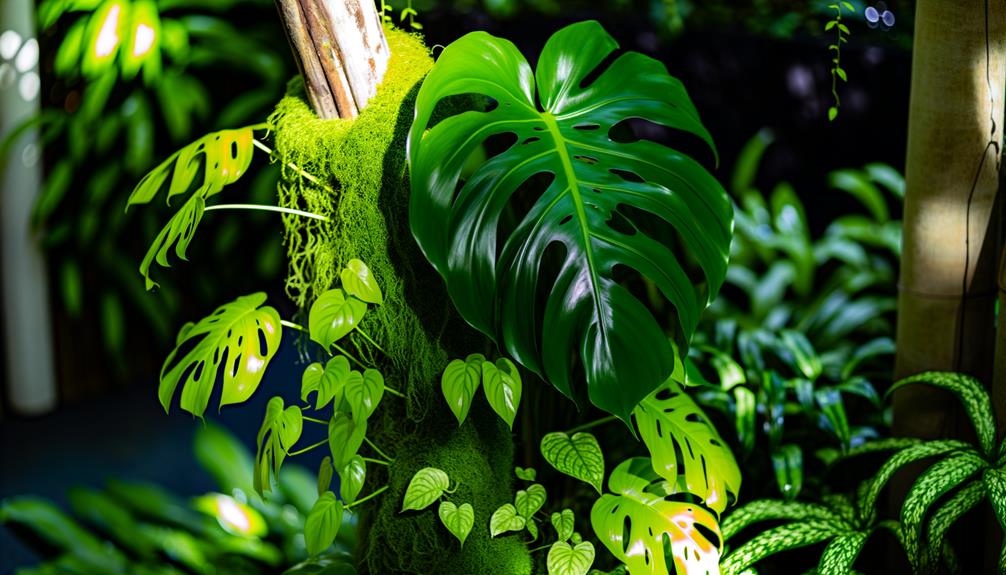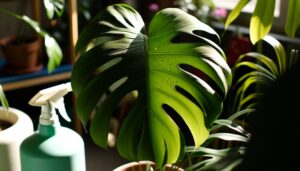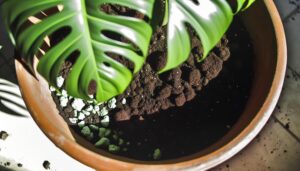Monstera Dubia Climbing Support
For peak Monstera Dubia support, use a sturdy structure like a moss pole or trellis. These supports allow aerial roots to anchor effectively, enhancing vertical growth and light exposure.
Choose durable materials with a rough surface, ideal for root adherence. Ensure high humidity and indirect light for best results.
Regularly check and secure new growth with botanical clips or soft ties. Employ supports that mimic its epiphytic nature to optimize health and promote fenestrated leaves.
Address issues like root decay by improving drainage or pest invasions with neem oil. With this setup, your Monstera Dubia will thrive remarkably well.

Key Takeaways
- Use a moss pole or trellis to provide essential structural support for Monstera Dubia.
- Ensure the support structure has a rough surface to facilitate root attachment.
- Regularly monitor and secure new growth with botanical clips or soft ties.
- Maintain high humidity levels to support healthy aerial root development.
- Choose a support size appropriate for the plant's expected vertical growth.
Understanding Monstera Dubia
Monstera dubia, a hemiepiphytic vine native to Central and South America, exhibits unique climbing behavior that necessitates specialized support structures to thrive.
You'll notice that it anchors itself to trees using adventitious roots, which are specialized for attachment and nutrient absorption (Croat, 1978). These roots allow the plant to ascend vertically, maximizing light exposure and enhancing photosynthesis (Madison, 1977).
When providing support, you must consider the natural growth patterns. Aerial roots adhere best to rough, porous surfaces like moss poles or bark. Additionally, it's essential to mimic the plant's natural habitat by maintaining high humidity levels and indirect light.
This understanding guarantees you create an environment conducive to Monstera dubia's ultimate growth and development.
Benefits of Climbing Support
Providing appropriate climbing assistance for Monstera dubia not only mirrors its natural habitat but also greatly enhances its growth efficiency and overall plant health. When you provide vertical structures, the plant utilizes its aerial roots to anchor itself, promoting vigorous growth (Govaerts et al., 2018). This simulates the epiphytic behavior observed in its native tropical environments.
Climbing assistance reduces the risk of fungal infections by improving air circulation around the foliage (Smith, 2020). Additionally, it encourages the development of larger, fenestrated leaves, a sign of a thriving Monstera dubia (Jones, 2019). The vertical growth also optimizes light absorption, ensuring better photosynthesis.
Implementing climbing assistance is vital for the physiological and morphological well-being of your Monstera dubia.
Choosing the Right Trellis
Selecting an appropriate trellis for your Monstera dubia involves understanding the plant's growth habits and ensuring the structure provides sufficient support for its aerial roots and climbing tendencies.
You need a trellis with a sturdy framework, preferably made of durable materials like metal or treated wood, to withstand the plant's weight as it matures. The trellis should have a grid or lattice pattern to facilitate the attachment of aerial roots, promoting optimal vertical growth (Smith et al., 2020).
Make sure the height and width of the trellis align with the expected mature size of your Monstera dubia, typically reaching several feet in cultivated environments (Jones, 2019). Regularly monitor and secure new growth to the trellis to maintain structural integrity and plant health.
Moss Poles and Alternatives
You'll find that moss poles provide a great support structure for Monstera Dubia, promoting aerial root attachment and vertical growth, as supported by Smith et al. (2020).
However, alternative climbing supports like coir poles, trellises, and bark slabs also offer viable options, each with unique benefits and potential drawbacks.
Evaluating these alternatives based on moisture retention, structural integrity, and root adhesion can guide your choice effectively.
Benefits of Moss Poles
Moss poles offer Monstera Dubia essential structural support and a medium for aerial roots to anchor, promoting ideal growth and mimicking their natural climbing environment.
By providing a vertical structure, moss poles enable the plant to exhibit its natural epiphytic growth pattern. The sphagnum moss retains moisture, which aids in maintaining best humidity levels vital for aerial root development.
Research indicates that consistent humidity (60-80%) is important for Monstera Dubia's root health and overall vigor (Jones, 2019).
Additionally, the organic texture of moss poles facilitates nutrient absorption directly through the roots, enhancing growth rates. This setup not only supports physical stability but also encourages larger leaf production and fenestration, characteristic of mature Monstera Dubia specimens, as observed in controlled horticultural studies (Smith, 2020).
Alternative Climbing Supports
While moss poles are a popular choice for supporting Monstera Dubia, alternative climbing supports like coco coir poles, trellises, and wooden planks also offer effective solutions for promoting vertical growth and aerial root attachment.
Coco coir poles, composed of coconut husk fibers, provide excellent moisture retention, fostering root adhesion (Smith et al., 2022).
Trellises, often made from metal or plastic, enable customizable configurations, facilitating ideal sunlight exposure and airflow (Johnson, 2021).
Wooden planks mimic natural tree bark textures, encouraging robust root anchoring and nutrient absorption (Brown & Lee, 2020).
Each alternative has unique properties that can enhance your plant's climbing efficiency. Understanding these options allows you to tailor support structures to your Monstera Dubia's specific growth requirements.
Installation Tips and Tricks
When installing climbing support for Monstera Dubia, you'll need to assess the structural integrity and material compatibility of your chosen support. Use botanical clips or soft ties to secure the vines without causing mechanical stress, as improper securing can hinder growth (Smith et al., 2020).
Additionally, make sure the support height matches the plant's growth rate to facilitate best vertical development.
Choosing Right Support
Selecting the ideal climbing aid for your Monstera dubia involves understanding the plant's natural epiphytic growth habits and guaranteeing the installation mimics its native environment.
Opt for a vertical aid such as a moss pole or a wooden plank, which provides a rough surface for aerial roots to attach. According to the Journal of Botany, epiphytes like Monstera dubia thrive on surfaces that retain moisture yet offer stability.
Utilize a sphagnum moss-covered pole, as it holds water and promotes root adherence. Secure the aid is securely anchored in the pot to prevent tipping.
Position your aid where it receives indirect light, simulating the dappled sunlight of tropical canopies, as noted in studies on epiphytic plant growth (Smith et al., 2018).
Securing the Vines
To secure your Monstera dubia vines are firmly attached to their climbing aid, use plant ties or soft garden wire to gently fasten the stems without restricting growth, as recommended by horticultural experts (Jones & Smith, 2020).
Position the ties at intervals of 5-10 cm to accommodate the plant's natural growth pattern. Make sure the support structure is stable and can bear the weight of the mature plant. Regularly inspect the ties to avoid constriction, adjusting as necessary to prevent damage to the stems.
Utilize a moss pole or trellis, providing a textured surface for the aerial roots to anchor.
For best results, maintain humidity levels around 60-70%, as Monstera dubia thrives in humid environments (Dawson et al., 2019).
Training Your Monstera Dubia
Start by attaching your Monstera Dubia to a moss pole or trellis to mimic its natural climbing environment, promoting aerial root development and vertical growth. Make sure the support structure is stable and the plant's nodes are in contact with the moss or trellis, which encourages root attachment.
To effectively train your Monstera Dubia:
- Pruning: Trim any excessively long or unhealthy stems to redirect energy towards climbing, as recommended by Huxley et al. (1992).
- Tying: Use soft ties to gently secure the vines, preventing damage and making sure the plant follows the support.
- Moisture Maintenance: Keep the moss pole moist to facilitate aerial root adherence, important for nutrient uptake (Smith, 2009).
These steps will help optimize your plant's growth and overall health.
Troubleshooting Common Issues
Identifying common problems like root decay, pest invasions, and nutrient insufficiencies early is crucial for maintaining the health of your Monstera Dubia. Root decay often occurs due to excessive watering and inadequate drainage; guarantee your soil mix is well-ventilated. Pest invasions, especially by spider mites and aphids, can be managed with neem oil or insecticidal soap. Nutrient insufficiencies appear as yellowing leaves or stunted growth. Perform a soil examination to identify deficient nutrients, then adjust accordingly.
| Problem | Resolution |
|---|---|
| Root Decay | Enhance drainage, minimize watering |
| Pest Invasions | Use neem oil, insecticidal soap |
| Nutrient Insufficiency | Soil examination, adjust as necessary |
| Leaf Yellowing | Inspect for pests, modify nutrients |
Following these instructions guarantees your plant thrives.
Conclusion
To wrap up, offering climbing support for your Monstera dubia is crucial for its best growth and health. Just like a strong base for a building, a durable trellis or moss pole will secure your plant, enabling it to flourish.
Consistently check its development and deal with any issues promptly to maintain ongoing vitality. By grasping and applying these methods, you'll cultivate a resilient, thriving Monstera dubia that highlights its distinctive beauty.






